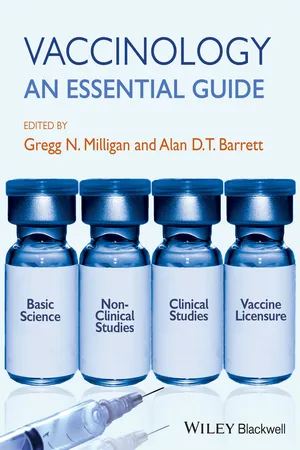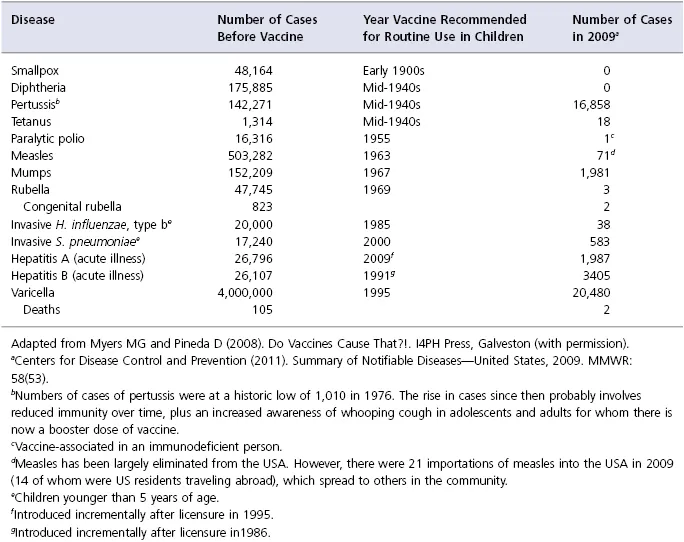
- English
- ePUB (mobile friendly)
- Available on iOS & Android
About This Book
Vaccinology: An Essential Guide outlines in a clear, practical format the entire vaccine development process, from conceptualization and basic immunological principles through to clinical testing and licensing of vaccines. With an outstanding introduction to the history and practice of vaccinology, it also guides the reader through the basic science relating to host immune responses to pathogens.
C overing the safety, regulatory, ethical, and economic and geographical issues that drive vaccine development and trials, it also presents vaccine delivery strategies, novel vaccine platforms (including experimental vaccines and pathogens), antigen development and selection, vaccine modelling, and the development of vaccines against emerging pathogens and agents of bioterror. There are also sections devoted to veterinary vaccines and associated regulatory processes.
Vaccinology: An Essential Guide is a perfect tool for designed for undergraduate and graduate microbiologists and immunologists, as well as residents, fellows and trainees of infectious disease and vaccinology. It is also suitable for all those involved in designing and conducting clinical vaccine trials, and is the ideal companion to the larger reference book Vaccinology: Principles and Practice.
Frequently asked questions
Information
1
The History of Vaccine Development and the Diseases Vaccines Prevent
Abbreviations
| CDC | US Centers for Disease Control and Prevention |
| CMI | Cell mediated immunity |
| CRS | Congenital rubella syndrome |
| HAV | Hepatitis A virus |
| HBIG | Hepatitis B immunoglobulin |
| HBsAg | Hepatitis B surface antigen |
| HBV | Hepatitis B virus |
| Hib | Haemophilus influenzae, Type b |
| HPV | Human papillomaviruses |
| IPD | Invasive pneumococcal disease |
| LAIV | Live attenuated influenza vaccine |
| MMR | Measles, mumps, and rubella |
| MMRV | Measles, mumps, rubella, and varicella |
| MVA | Modified Vaccinia Ankara |
| PCV7 | Heptavalent pneumococcal conjugate vaccine |
| PHN | Postherpetic neuralgia |
| PPS23 | 23-valent pneumococcal polysaccharide vaccine |
| PRP | Polyribosylribitol phosphate |
| SSPE | Subacute sclerosing panencephalitis |
| TIV | Trivalent inactivated influenza vaccine |
| VAPP | Vaccine-associated paralytic poliomyelitis |
| VZIG | Human anti-varicella immunoglobulin |
| VZV | Varicella zoster virus |
The 18th Century: Vaccines for Smallpox
Diseases Caused by Bacteria and Viruses Where the Name of the Organism and the Disease Is Not the Same
- Chickenpox (varicella): Varicella zoster virus
- Diphtheria: Corynebacterium diphtheriae
- Intestinal tuberculosis: Mycobacterium bovis
- Pertussis (“whooping cough”): Bordetella pertussis
- Q fever: Coxiella burnetii
- Shingles: Varicella zoster virus
- Syphilis: Treponema pallidum
- Tetanus (“lockjaw”): Clostridium tetani
- Typhoid fever: Salmonella typhi
The 19th Century: New Understanding of Infectious Diseases and Immunity
The 20th Century: The Control of Diseases Using Vaccines

Vaccines
Table of contents
- Cover
- Table of Contents
- Title page
- Copyright page
- Contributors
- Preface
- 1: The History of Vaccine Development and the Diseases Vaccines Prevent
- 2: The vaccine Development Pathway
- 3: Control and Eradication of Human and Animal Diseases by Vaccination
- 4: Pathogenesis of Infectious Diseases and Mechanisms of Immunity
- 5: The Host Immune Response, Protective Immunity, and Correlates of Protection
- 6: Adjuvants: Making Vaccines Immunogenic
- 7: Discovery and the Basic Science Phase of Vaccine Development
- 8: Microbial-Based and Material-Based Vaccine Delivery Systems
- 9: Licensed Vaccines for Humans
- 10: Veterinary Vaccines
- 11: Development of Vaccines for Microbial Diseases
- 12: The regulatory Path to Vaccine Licensure
- 13: Veterinary Vaccines: Regulations and Impact on Emerging Infectious Diseases
- 14: Vaccine Manufacturing
- 15: Clinical Evaluation of Vaccines
- 16: Vaccine Recommendations and Special Populations
- 17: Vaccine Safety
- 18: Understanding and Measuring the Dynamics of Infectious Disease Transmission
- 19: Vaccines from a Global Perspective
- 20: Political, Ethical, Social, and Psychological Aspects of Vaccinology
- Index
- End User License Agreement